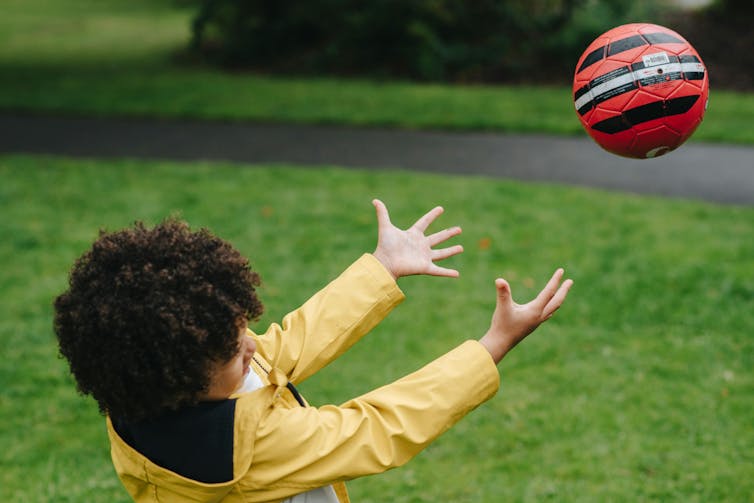The Greatest Guide To 4throws
Wiki Article
4throws Can Be Fun For Everyone
Table of ContentsThe 8-Minute Rule for 4throwsIndicators on 4throws You Need To Know4throws for DummiesThe smart Trick of 4throws That Nobody is DiscussingSome Of 4throws
Resource: US Flying Force It's always fun to see who can throw something the outermost, whether it's a round, a Frisbee, or perhaps a rock. Track and area is the area where you can throw stuff for distance as an actual sporting activity. There are 4 significant tossing events outlined below.The men's university and Olympic discus considers 2 kgs (4.4 pounds). The women's college and Olympic discus evaluates 1 kilogram (2.2 pounds). The discus is tossed from a concrete circle that is about 8 feet in diameter. The professional athlete's feet can not leave the circle prior to the discus lands or the professional athlete will certainly fault and the throw won't count.
The athlete that tosses it furthest from the front part of the circle (and within the lawful location) wins. The males's college and Olympic javelin evaluates 800 grams (28.2 ounces) and is concerning 8.5 feet long.
Some Known Incorrect Statements About 4throws
The athlete that throws it furthest (and within the lawful location) wins. In the shot placed event professional athletes throw a steel round.The athlete can not touch the top of the toe board or action over it during the toss. There are 2 common throwing methods: The very first has the professional athlete slide or "glide" from the back to the front of the circle prior to launching the shot.

Examine This Report on 4throws
In this track and area tossing event the professional athlete tosses a metal sphere affixed to a manage and a straight cord concerning 3 feet long. The guys's university and Olympic hammer weighs 16 pounds. The ladies's university and Olympic hammer considers 4 kilos (8.8 extra pounds). The hammer is tossed from a concrete circle 7 feet in diameter (just like the shot placed) but there is no toe board.The professional athlete spins numerous times to get momentum prior to launching and tossing the hammer. Balance is essential because of the force created by having the heavy sphere at the end of the cord. The athlete that tosses it outermost from the front part of the circle (and within the legal location) wins.
We found that human beings have the ability to toss with such rate by saving flexible power in their shoulders. This is accomplished by placing the arm as if the arm's mass resists movements created at the upper body and shoulder and revolves in reverse far from the target. This "cocking" of the arm stretches the ligaments, ligaments, and muscular tissues crossing the shoulder and shops flexible energy (like a slingshot).
We located that human beings are able to throw with such rate by storing flexible energy in their shoulders. This is achieved by placing the arm in such a way that the arm's mass stands up to motions generated at the upper body and shoulder and revolves backwards far from the target. Javelins. This "cocking" of the arm extends the tendons, ligaments, and muscle mass going across the shoulder and shops flexible power (like a slingshot)
The smart Trick of 4throws That Nobody is Talking About
(https://www.edocr.com/v/8d95dgz6/jamesmiller33101/4throws)This more upper body turning generates huge forces required to stretch the flexible ligaments and tendons in the shoulder. The reducing of the shoulder alters the orientation of lots of shoulder muscles, including the pectoralis significant (the large upper body muscular tissue), which is important to keeping energy. Lastly, we located that low humeral torsion (the twisting of the arm bone) enables us to keep more power and hence, throw faster.
Target-based sporting activities have 2 major categories: bowling and darts, each of which have a multitude of variations. Throwing sports have a lengthy background. Modern track and field originates from a family tree of activities that dates to the Ancient Olympic Gamings. Artwork from Old Greece. Discus kids, in the form of friezes, pottery and statuaries, confirms to the prestige of such sporting activities in the culture's physical society.
Usual one-armed tossing approaches include overhand throwing (launching with the arm over the shoulder) and underarm throwing (launching with the arm below the shoulder). With both arms, overhead throwing and chest-passing prevail activities. The kind of toss made use of is extremely influenced by the residential or commercial properties of the projectile: little, hefty objects are held and pressed far from the body (e.g.
5 Simple Techniques For 4throws
weight toss, keg throw); smaller sized, lighter things such as spheres and darts tend to make use of an extended overarm strategy where range or speed is needed, and an underarm technique where greater accuracy is required. In these sports, many throws are extracted from a static setting or restricted location. Some sports do consist of a short run-up to the toss line, for instance javelin toss and ten-pin bowling.Report this wiki page